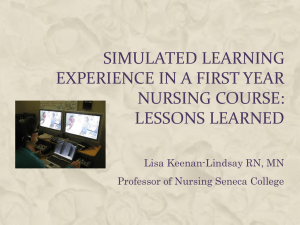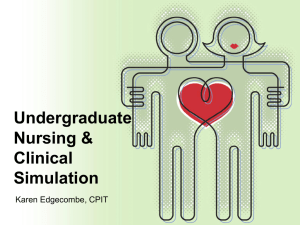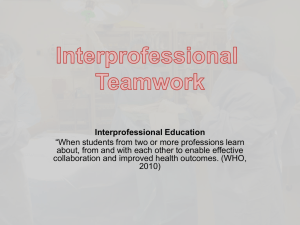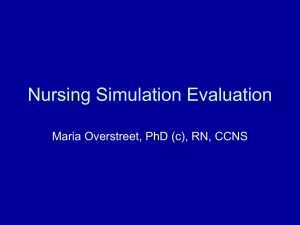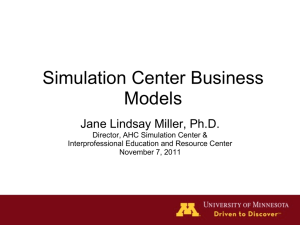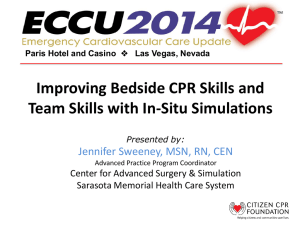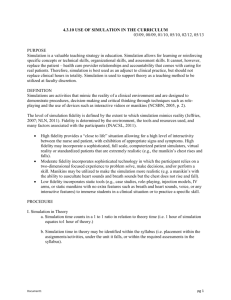Lone Star College- Kingwood Hospital
advertisement
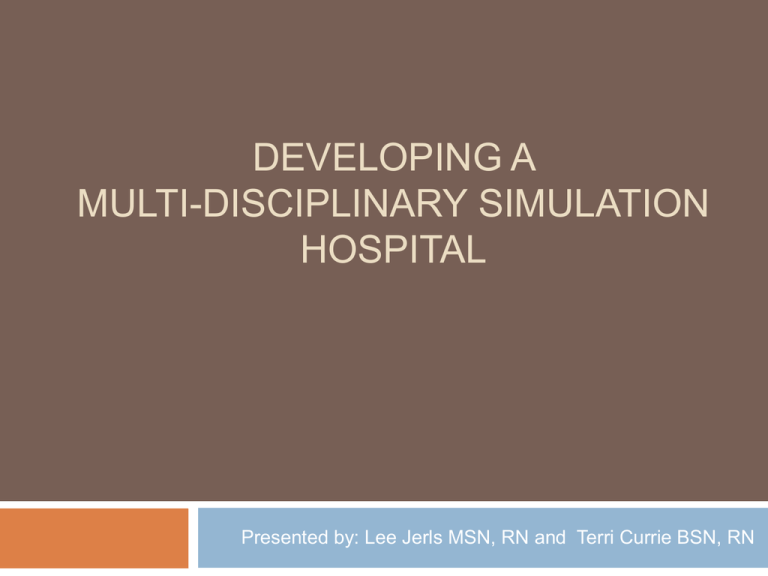
DEVELOPING A MULTI-DISCIPLINARY SIMULATION HOSPITAL Presented by: Lee Jerls MSN, RN and Terri Currie BSN, RN Definition • Simulation – – An attempt to mimic essential aspects of a clinical simulation with the goal of understanding and managing the situation better when it occurs in actual clinical practice. A technique that uses a situation or environment created to allow persons to experience a representation of a real event for the purpose of practice, learning, evaluation, testing, or to gain understanding of systems or human actions ( Definition: Fidelity Fidelity The degree to which either a simulation encounter or simulation equipment approaches reality (http://sirc.nln.org/mod/resource/view ) Types: Low fidelity manikins Medium fidelity manikins High fidelity manikins Why Simulation? “Carnegie Foundation for the Advancement of Teaching Report” (Benner, Sutphen, Leonard, & Day, 2009) “ From focus on covering decontextualized knowledge…to sense of salience, situated cognition and action in a particular situation; From a sharp separation of clinical and classroom teaching to integration of classroom and clinical teaching; From an emphasis on critical thinking to clinical reasoning and multiple ways of thinking that include critical thinking; and From an emphasis on socialization and role taking to an emphasis on formation.” Learning Theories Constructivism learning therapy Adult-learning theory Brain-based learning theory Social-cognitive learning theory Experiential learning theory Novice-to expert theory A new pedagogy?? The Journey…. LSC-K Hospital History (2007) Appreciative Inquiry (early 2008) Lack-of-realism Roles and responsibilities Orientation to the unit and equipment Faculty continuity Scenario development Literature Review Jeffries Simulation Model (2005) S.T.E.P. Educator Preparation Plan S.T.E.P. Simulation Take Educator Preparation (Jeffries, 2008) Standardized Materials Train the Trainer Encourage the development of a simulation design and integration team Plan to coordinate the simulation development and implementation activities S.W.O.T. Method Strengths Weakness Opportunities Threats (Rothgeb, 2008) Integration Into the Program Identification of a champion Scheduling Simple first steps Flexibility Debriefing (Leigh & Hurst, 2008) Simulation Design Objectives Planning Fidelity Complexity Cues Debriefing (Jeffries, 2005) Evaluation Process Debriefing Reflection Tools National League for Nursing • The Simulation Design Scale (student version), a 20-item instrument using a fivepoint scale, was designed to evaluate the five design features of the instructordeveloped simulations used in the NLN/Laerdal study. • Educational Practices Questionnaire (student version), a 16-item instrument using a five-point scale, was designed to measure whether four educational practices (active learning, collaboration, diverse ways of learning, and high expectations) are present in the instructor-developed simulation, and the importance of each practice to the learner. • Student Satisfaction and Self-Confidence in Learning, a 13-item instrument designed to measure student satisfaction (five items) with the simulation activity and self-confidence in learning (eight items) using a five-point scale. • http://sirc.nln.org/mod/resource/view Chickering, A.W., & Gamson, A.F., (1987). Seven principles for good practice in undergraduate education. Racine, WI: The Johnson Foundation, Inc./Wingspread Lone Star College- Kingwood Hospital A day in the life of a student nurse at LSC-K Hospital… Lone Star College- Kingwood Hospital Mission: to deliver safe and prudent quality care while maintaining ethical, professional, and culturally acceptable standards through utilization of evidence-based practice an innovative technology Vision: to facilitate the growth of the novice learner to the expert clinician, enhancing critical thinking skills and selfconfidence in a safe, realistic, and non-threatening environment. Orientation Process • LSC-K Hospital – – – – – – – – – Roles and responsibilities Patient information Confidentiality form Scavenger hunt Equipment Crash carts Paging system Documentation EMAR I want to insert a picture here Report Patient Census Level Roles and responsibilities Primary nurse Secondary nurse Family member Observer Interdisciplinary team Multi-Patient Unit Multi-Disciplinary Unit Nursing disciplines Nursing levels Respiratory therapy Occupational therapy Debriefing References Benner, P., Sutphen, M., Leonard, V., & Day, L. (2009). Educating nurses: A call for radical transformation. San Francisco: Jossey-Bass. Jeffries, P. R. (2005). A framework for designing, implementing, and evaluating simulations used as teaching strategies in nursing. Nursing Education Perspectives , 96-103. Jeffries, P. R. (2008). Getting in S.T.E.P. with Simulations: Simulations Take educator Preparation. Nursing Education Perspectives , 70-73. Leigh, G., & Hurst, H. (2008). We have a high-fidelity simulator, now what? making the most of simulators. International Journal of Nursing Education Scholarship , 1-10. Rothgeb, M. K. (2008). Creating a nursing simulation laboratory: a literature review. Journal of Nursing Education , 489-494.

